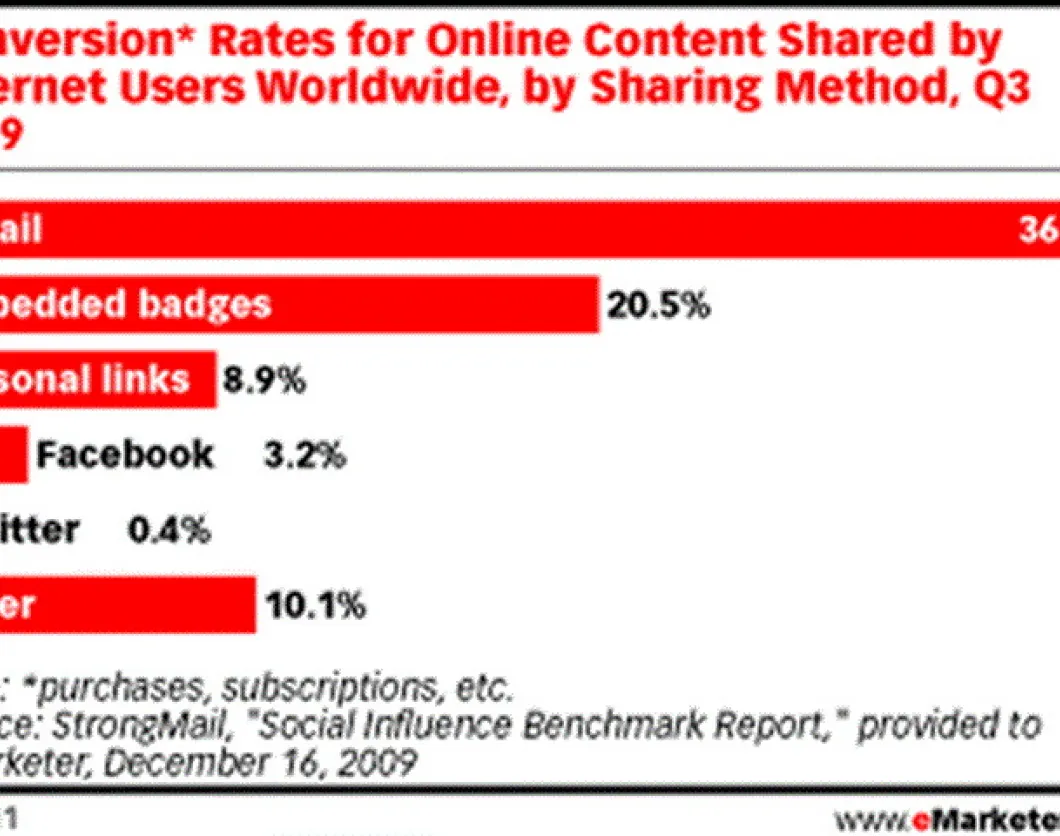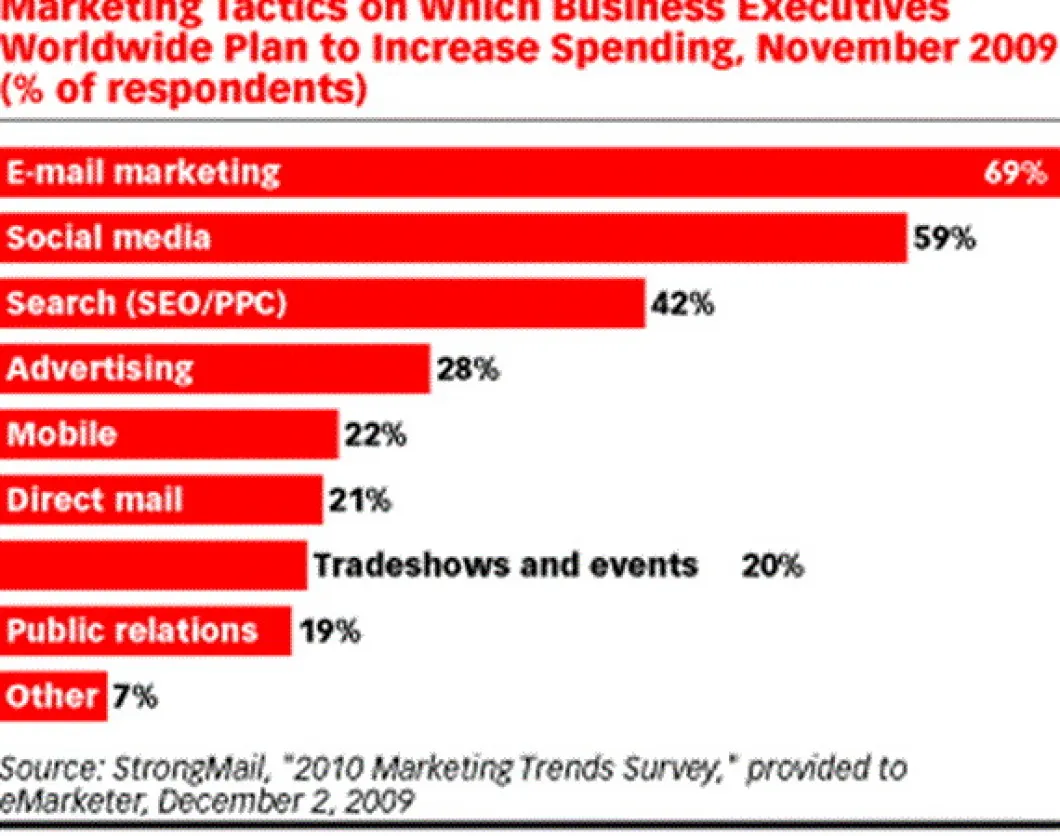Social Media and Web 2.0 applications as integrative elements of the online marketing mix have grown significantly in the last few years. The most important principle of social media is the direct interaction with and between users and the exchange of information. Many tourism businesses and organizations plan to set up blogs and to increase their communication activities on social networks such as Facebook, YouTube and Flickr in the next months with the goals to generate more website traffic and increase brand awareness. This trend is also underpinned by the “2010 Social Media Marketing Benchmark Report” from MarketingSherpa, published by eMarketer (21 Dec 2009).
Increasing website traffic significantly outranks other marketing objectives such as increasing leads and sales revenues or improving search engine rankings and brand awareness. Half of the marketing managers from the travel and leisure industry claimed they intended to increase the budget for social media marketing in 2010, according to the “2010 Social Media Benchmark Report”, for which 2,317 US marketers were questioned about their marketing budget plans.
E-mail Newsletter Drives Conversions
In spite of the hype and growing popularity of social networks, recent surveys revealed that it is still the e-mail newsletter that can lead to high conversion (e.g. purchases, subscriptions etc.) and user engagement rates. E-mail is obviously still the king of online content sharing, according to a survey carried out by StrongMail and published by eMarketer (23 Dec 2009). E-mail links achieved conversion rates of nearly 37% for online content shared by Internet users, whereas Facebook led to conversion rates of 3% and Twitter of 0.4%.
Benefits of email marketing compared to other online marketing formats comprise the relatively low fulfillment costs, the faster campaign deployment, the convenience of personalization and targeting, the simple and cost effective options for testing, the combination with other online marketing goals such as driving traffic to the website, and finally the many possibilities for a detailed reporting in real time which facilitates a thorough analysis and optimization.
Evidently, the combination of e-mail marketing and social media is the favored marketing tactic to lure more visitors to the website, which is also reflected in the marketing budget plans for the year 2010. Seven out of ten business executives around the world are going to increase the budget for e-mail marketing and 60% will spend more money for social media marketing.
Nevertheless, other marketing activities such as search engine marketing, banner advertising, ads on mobile applications, strategic e-partnerships and many more still have their share in the marketing mix.
Definition of Objectives and Performance Metrics Is Key to Success
Social media marketing has also led to an extension of the traditional A-I-D-A (attention – interest – desire – action) model. The combination of integrated and cross-linked marketing communications aims to catch the customers’ attention and eventually lure them to the company’s website (action). There the users should keep on searching and experiencing the offers. In order to make effective use of the customers’ word-of-mouth in their networks they should get motivated to share and create content. Thus, the A-I-D-A model is extended to attention – interest – desire – search – experience – share.
It is essential for all online marketing activities, though, that the objectives and metrics of how to measure these objectives are clearly defined. All marketing communications must be targeted and geared to the user needs. Online marketing activities can only be successful, if they are
- relevant for the customers in order to increase user engagement,
- precisely targeted (e.g. according to the customers’ interests and through local geo-targeting),
- used in a way to create deeper connections and continuous interactions with the customers,
- constantly monitored and optimized.
User Typology and Principles of Social Media Marketing
Blogs, Wikis and social networking and content sharing websites like Facebook, YouTube, Flickr, Twitter and many others have become rather popular among tourism businesses and organizations. There is hardly a destination or business that has not set up a Facebook fanpage, a Blog or a branded YouTube channel yet or at least considers doing so in the near future. Online socializing has become a well-established pastime and amusement among all age groups.
Blogs serve many purposes, from online diaries to corporate public relations. Some of the essential aspects of blogging are that they encourage readers to comment on individual posts and that other bloggers can link to posts with criticism, praise or merely to point to an interesting article, thus they allow people with common interests to interact with one another. The most interesting ideas emerge in many cases not in the original post but in the discussion generated by comments.
About 65% of the 1.1 billion worldwide internet users older than 15 years visited at least one social networking site during May 2009, according to a survey conducted by comScore. An average user spent 3.7 hours per month on community platforms visiting 525 pages. Interestingly, Russian web users showed the highest involvement in social networking with an average of 6.6 hours per month. The United Kingdom (4.6 hours) and Germany (4.5 hours) followed on the ranks seven and eight, whereas Swiss Internet users only spent 3.2 hours on average on community websites. In the UK nine out of ten internet users aged between 25 to 34 years old visited a social networking platform each month (comScore May 2009).
According to Josh Bernoff (2008), social consumer behavior can be classified according to six different user types. The first type is the creator who is actively participating in online communities through publishing videos, websites, music and blogs. The critics are users who are publishing reviews about products and services and are commenting on other users’ statements and reviews. The collectors are using RSS feeds and tags heavily. The joiners are active members of social network sites and are frequently visiting them. The spectators are passively reading other users’ reviews and are watching other users’ videos. However, they are not actively participating in online communities. The last group are the inactives who are not participating at all in online communities.
Despite that this classification is used for online users in general, the same classification can be applied to users of social network sites. According to Forrester Research (2009), 15 per cent of all male online users are creators, whereas 20 per cent are critics and six per cent are collectors. Only 16 per cent are joiners and 52 per cent are spectators. Therefore, 40 per cent of all users are inactive. With regard to women, the picture looks similar with a vast majority of passive users.
Forrester Research further developed five significant age categories being 18-24, 25-34, 35-44, 45-54 and 55+. Overall, it can be said that the percentage of creators, collectors, critics, joiners and spectators decreases with each age category whereas the number of inactives increases reaching a peak of in the age category 55+ (for details visit: www.forrester.com/Groundswell/profile_tool.html).
Many tourism businesses are still reluctant to turn their efforts to social media marketing. Apart from a lack of social marketing knowledge and concerns about an increased work load, it is often the fear of losing control over the content and in turn over the advertising message. Monitoring and “listening” to the communication of the customer segments on the respective platforms is essential. Moreover, social media marketing certainly requires a deeper understanding of the hedonistic motives of the customers.
Social media marketing is not so much about what is in it for the company but rather what is in it for the users, what is the added value the users get for their active participation. The return on investment happens mostly indirectly through an increased return on communication and a better understanding of customer needs.
By Professor (FH) Mag. Christian Maurer










